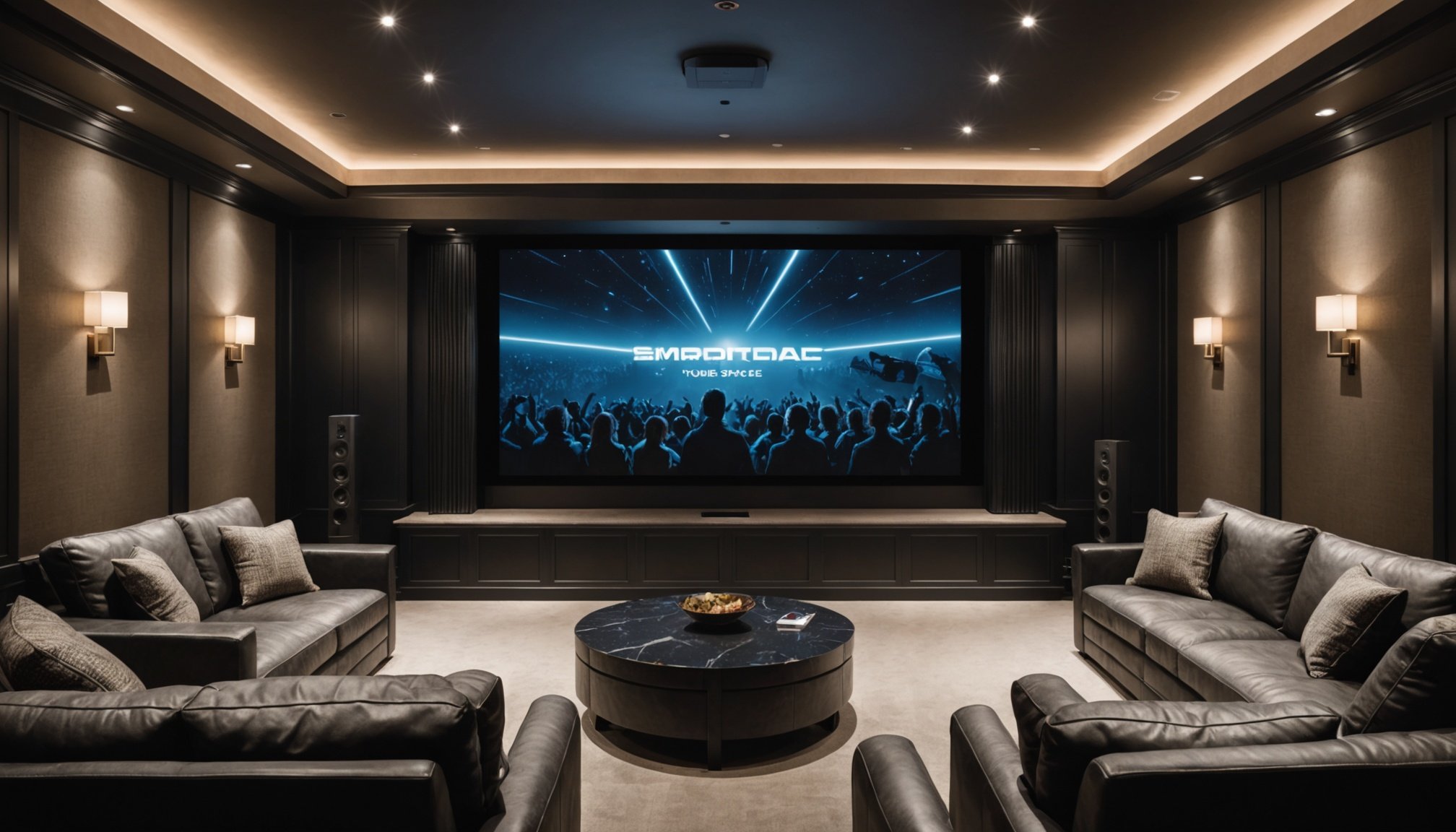Overview of Home Theater Basics
Creating an engaging home theater setup involves combining various components to achieve an unforgettable immersive experience. Fundamentally, a home theater consists of a high-definition television or a projector coupled with a robust sound system. These components together generate a captivating environment that replicates cinema-quality viewing at home.
Key elements such as sound quality and visual acuity are crucial. High-resolution displays enhance picture detail, while superior audio systems envelop you in rich, dynamic sound. Dolby Atmos systems or similar surround sound technologies can make the experience truly immersive, making you feel part of the on-screen action.
Have you seen this : Unlock Your Smartphone Effortlessly: Expert Tips for Mastering Remote Desktop Access
The benefits of an immersive audio-visual experience extend beyond mere entertainment. Such setups enhance engagement whether you’re watching a movie, gaming, or streaming your favourite series. Not only does it bring stories to life, but it also creates a space where you can escape and unwind.
Consideration of the room’s layout, including speaker placement and seating arrangement, contributes significantly to optimal sound distribution and viewing angles, further amplifying the immersive experience. When each component works harmoniously, your home theater becomes a portal to vibrant sights and sounds.
Additional reading : Unlock Your Smartphone Effortlessly: Expert Tips for Mastering Remote Desktop Access
Selecting the Right Speakers and Sound Systems
Choosing the best speakers and sound systems is vital for a rich audio experience in your home theater. Different types of speakers, such as floor-standing, bookshelf, and soundbars, each offer unique strengths. Floor-standing speakers deliver robust sound for larger spaces, while bookshelf speakers fit well in smaller setups, providing balanced audio quality. Soundbars are ideal for compact areas and offer simplicity in installation and configuration.
Recommended brands for various budget considerations include Sonos, known for its wireless systems, and Klipsch, prized for high-fidelity sound. For budget-conscious audiophiles, Polk Audio offers excellent performance without breaking the bank. The placement of these speakers significantly impacts the overall sound quality. Positioning them at ear level, ensuring they are equidistant from the listener, optimizes audio distribution throughout the room.
Placing subwoofers strategically enhances bass impact, enriching the whole audio experience. Some experts suggest placing them in the corners of the room to fully engage room acoustics. Integrating these elements carefully can transform your space, delivering an immersive audio quality that elevates viewing experiences.
Recommended Smartphone Apps for Home Theater Control
Smartphone apps have revolutionized how users interact with their home theater setup, providing seamless control and automation. These apps offer the convenience of adjusting your entire system from the palm of your hand, enhancing the immersive experience.
Overview of Popular Apps
Several popular smartphone apps offer control systems for managing sound systems and projectors. Apps like Sonos, Harmony Hub, and Yonomi allow users to adjust sound levels, switch sources, and even automate different settings based on the time or activity. These solutions streamline the operation of a home theater, making management intuitive for users of any tech-savviness level.
Benefits of Smartphone Apps
The ease of using smartphone apps can’t be overstated. Having full control without constantly adjusting physical settings enhances user engagement. Integration of apps with existing home automation systems is a major benefit, as it allows unified control of multiple devices through a single interface.
Integration of Home Automation
Integrating smartphone apps with home automation further personalises the theater experience. By synchronising the lighting, sound, and screen settings, users can create custom scenes. These tailored experiences turn a regular movie night into an unforgettable immersive adventure.
Step-by-Step Installation Guide
Embarking on a DIY home theater setup can be a rewarding adventure with the right installation guide at your disposal. Attention to detail ensures your experience is smooth and rewarding.
Wiring and Connectivity
Begin the process by considering proper wiring techniques and connectivity options. High-quality HDMI cables are crucial for seamless video connections, while reliable speaker wiring adds clarity to audio. Organize cables to prevent clutter and ensure safe connections, using cable management solutions as needed to maintain a tidy setup.
Mounting Speakers and Screens
Mounting your speakers and screens correctly maximizes the immersive experience. Screens should be at eye level for optimal viewing, reducing strain during extended viewing sessions. Ensure speakers are positioned for the best sound directionality; they should ideally be at ear level when seated. Wall mounts or stands offer flexibility and can be adjusted to enhance sound distribution.
Configuring the Sound System
Configuring your sound system involves precise audio calibration. Utilize built-in room correction features or manual adjustments to balance sound levels across different speakers. Test various settings to find those that deliver the richest and most dynamic audio quality, transforming your space into a personal cinema flawlessly.
Design Layout Suggestions for Optimal Sound
Achieving perfect audio in a home theater setup requires careful consideration of design layout. Effective sound optimization hinges significantly on understanding room acoustics, which involve how sound waves interact with the space and its contents.
Key factors include the room’s dimensions and shape. Irregularly shaped rooms often diffuse sound better than perfect squares, reducing echo and providing a smoother auditory experience. The size of the room also impacts sound quality; larger spaces may require more powerful speakers or additional acoustic treatments.
Furniture and decor play a vital role in enhancing acoustics. Soft furnishings like curtains, carpets, and cushions absorb sound, preventing unwanted reverberations. They can act as natural acoustic dampeners, making the audio clearer and more direct.
The room’s layout, including speaker positioning and seating arrangements, is crucial for sound distribution. Speakers should be angled towards the listening area, with the main listening position forming an equilateral triangle with the front speakers for balanced sound.
Strategically using room elements to manage acoustics results in a more immersive experience, allowing every whisper or explosion in your film to be heard perfectly.
Troubleshooting Common Issues in Home Theater
Maintaining a flawless home theater setup can sometimes be challenging, particularly when faced with common issues. Regular troubleshooting techniques are invaluable for sustaining an optimal performance level.
Identifying Common Problems
Problems arise frequently with sound and video feeds. Sound issues may include distorted audio, missing channels, or unbalanced levels. Visually, connectivity glitches can lead to static displays or image lag.
Steps to Resolve Connectivity and Sound Quality Issues
For sound, first assess speaker connections. Ensure cables are securely plugged in. Check audio settings in both the source and amplifier systems. If connections are firm and problems persist, consider resetting your audio system or alternating between different audio modes. For video issues, always inspect HDMI connections and switch cables if necessary to bypass any potential faults.
Regular Maintenance Tips
Routine maintenance is crucial for longevity. Regularly dust components and clean connections. Periodic updates of your home theater’s firmware and software can ameliorate performance by resolving bugs. Keeping your equipment in a dust-free environment and performing periodic checks will ensure you enjoy a high-quality, uninterrupted immersive experience.
Product Comparisons for Optimal Choices
Choosing the right speakers and sound systems is crucial for any home theater setup. With an array of product comparisons available, discerning the best option can seem daunting. Popular brands like Sonos offer high-quality audio equipment known for wireless convenience, while Klipsch is celebrated for powerful sound delivery.
Key Features and Cost-Effectiveness
When considering speakers, look for features like frequency range and wattage for superior audio quality. Speaker reviews often highlight models with balanced sound and robust build, helping you make informed decisions. By focusing on room acoustics alongside equipment properties, you maintain sound clarity across diverse listening environments.
Exploring Trade-offs
Trade-offs between performance and budget remain critical. Higher-end models often promise better clarity and durability, but mid-range options commonly achieve a satisfying balance of features. Investing in quality audio equipment often translates to less frequent upgrades.
System Comparisons
For comprehensive system comparisons, examining the connectivity options and ease of installation is beneficial. Systems that integrate seamlessly with smart technologies can enhance the immersive experience without hassle. By comparing, one can maximise both performance and value, ensuring that your home theater delivers on multiple fronts.
Integrating Additional Features for Enhanced Experience
To truly elevate your home theater setup, consider incorporating smart features for enhanced control and convenience. These elements not only add a layer of sophistication but also streamline the user’s immersive experience by automating various aspects of the system.
Smart Home Technology
Integrating smart home technology can significantly enhance your theater. Smart assistants, like Alexa or Google Home, allow voice-controlled operation of lights, curtains, and even the audiovisual setup. This hands-free interaction enables seamless adjustments without interruptions, making the experience fluid and effortless.
Additional Features
Enhancing the ambiance through lighting control can transform your space. Smart lighting systems enable dynamic adjustments, such as dimming lights to improve picture contrast or creating mood settings that enhance dramatic scenes. Curtain control adds practicality by managing ambient light and glare, making the entertainment environment more intimate and immersive.
Future Trends
The future of home theater lies in deeper integration capabilities. Advanced technology trends predict more cohesive interfaces, where devices communicate effortlessly, crafting an even more interconnected environment. Iterating on present technology will open doors to more personalized and adaptable theater experiences. Embracing these innovations positions your home theater at the forefront of both technology and entertainment.











